I’ve attended enough international dance festivals to notice that their curation often seems to balance between appealing to a wide range of audience interests and assembling a ‘best of’ lineup of the hottest premieres of the season. Leaning towards the first imperative may allow for a diverse and crowd-pleasing mix, but often lacks clear artistic direction. The second approach can result in a loosely defined thematic umbrella that feels somewhat secondary to the actual show selection. By no means do I imply that such curation is inherently lacking: such are the realities of today’s art scene, where curators are bound to navigate between funding and co-production requirements and the ever-present need to showcase what’s new. Narratively cohesive programming choices, guided by the same central storyline where works can meaningfully echo each other and interact, still remain an exception – making every such endeavour all the more intriguing to explore. This spring, Berlin’s Sophiensaele proved a prime example, offering a festival experience as compelling as it is unique.
‘We live among ruins. Although they don’t always appear as we expect’, sets forth the programme note of Making Life in the Ruins – International Performance Festival produced this May by Sophiensaele and curated by Mateusz Szymanówka and Lena Kollender. Thinking of ‘ruins’ in modern-day Germany instantly brings to mind a flurry of references: German 19th-century romanticism wistfully sublimating antique ruined grandeur; ruination that this same Germany is contributing to by selling arms to foreign warmongers; and relics that it has looted over the centuries to pack its museum collections. Too literal and specific; and too distant for any festival to explore. ‘Ruins’ here are instead a speculation: they are both ghostly and tangible, present and bygone, mythical and intimate. And they come with a question mark: which deserve saving and grieving, and which should fall? Shaped as a garden of winding paths, the festival offers countless meanings and reflection points, but few answers. Let’s see where the paths take us.
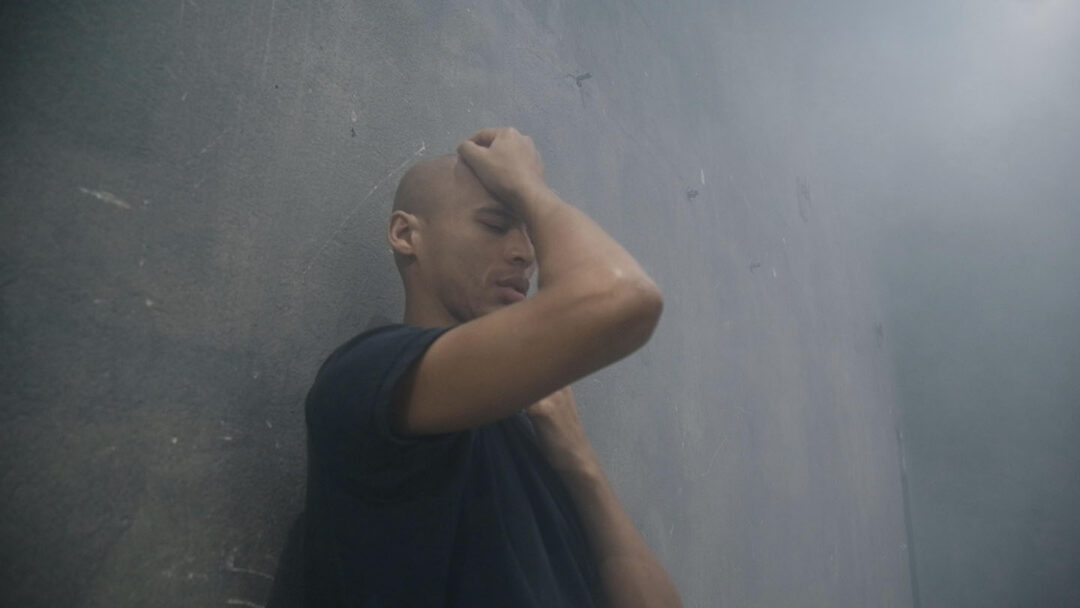
Ruins of the past
Remains of bygone eras, lingering remnants and ghostly souvenirs of past experiences: Tiran Willemse’s solo work Untitled (Nostalgia, Act 3), presented at the outset of the festival, teases open all usual ‘ruin’ flavours in a spellbinding act of dance exorcism. Willemse draws from a kaleidoscope of dance histories that had once traversed and shaped his body: Perrot’s Giselle, Angolan Kuduro dance, and the Nigerian genre Alanta. And if the Giselle section that opens the show is gentle and almost fragile in its endless repetition and fingertip-level clarity, the ensuing genre fusion is not simply stylistic: Willemse throws himself into a whirlwind where moves overlap and collide, creating a sense of a body in limbo. As if freed from being possessed by a Giselle ghost, Willemse prances across the stage in angular jumps and twirls, laughs and giggles with his eyes closed and his arms whiplashing in front. His relentless journey is interrupted by short stumbles where, as if manipulated by a puppeteer, he grimaces with his tongue stuck out, trembles and jumps out in another deconstructed sequence. Tobias Koch’s haunting soundscape is present yet sparse: melancholic piano arpeggios leave space to buzzing metal sound and trippy bits. Willemse does not choreograph in a traditional way: there is hardly a single visible transition. Rather than connecting movement patterns and stories as jigsaw puzzle pieces, he overlaps them often in one single dance phrase, and with speed-defying imagination. His exploration of past selves and ever-present ghosts is not nostalgic, as the title might suggest. It is a sweaty fistfight and a glorious carnival. Nor is it a career-culminating revue: Willemse’s evocation of Black experiences on western dance stages is eminently political. When he mangles his face in ghoulish clowny grimaces reminiscent of racist stereotypes still prevalent in western societies not so long ago, the audience is petrified and for a reason. Not all the demons have left.
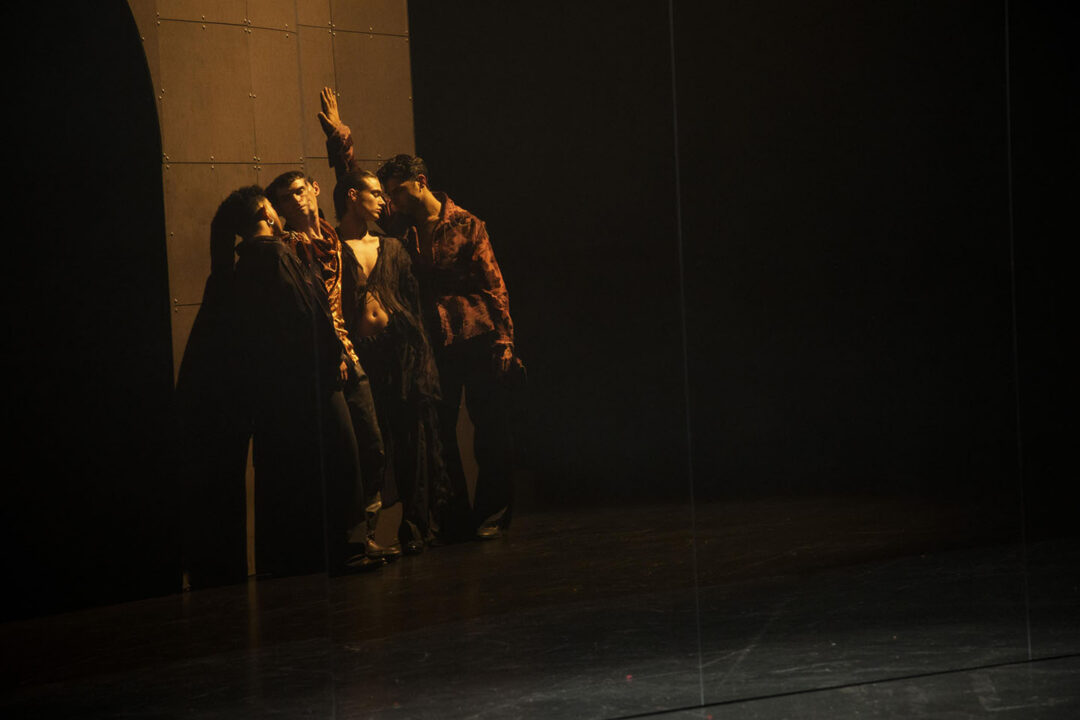
Ruins that are here and now, in the making or not so far away, have found their way to Sophiensaele’s stages too. In And Now It Is Night Enad Marouf conjures a hypnotic cruising scene between strangers in a riveting set. The dancers perform behind a monumental architectural installation reminiscent of old Damascus by night, with most of their dance visible as shadowy reflection in a mirror mounting upstage. This smart set design lends epic visual and sensual depth to the fragmented exploration of the uncertainty of desire that this work dispatches. Back to Berlin, local artists and DJs Hassandra and marumconjured a half-séance, half-tour of Berlin club culture. Called What We Witnessed Amongst the Wreckage Tour, this performative after-party includes a crash course into Berlin club’s lifestyle and politics, listening sessions on cosy couches and quirky interactions between the audience and Hassandra, inquiring in a provocative yet nostalgic manner about our best (and worst!) party recollections. The performance is, however, cut short: everyone is invited to go outside with a detailed expulsion letter – a deft reminder about how quickly even a party space may become extinct.
Basel Zaraa’s performative installation Dear Laila tells a story of a real ruin. When his daughter asked him to see his childhood home – long destroyed as part of Yarmouk Palestinian refugee camp – Zaraa rebuilt it as a miniature, set now atop a wooden desk in the dimly lit space that spectators visit one by one. Through a headset, his story unfolds, growing tactile as he invites each visitor to uncover his grandmother’s prayer beads and the family’s key hidden in drawers. Experienced alone, Dear Laila becomes a place of grief and sorrow far from usual theatrical distractions. Generational trauma, displacement, exile and resilience of Palestinian people grow achingly real and leave few unmoved. Estonian choreographer Netti Nüganen brings a mischievous touch to the ruins of history in The Myth: last day. In the opening scene of her quirky and caustic show she literally emerges from the rubble and slowly explores a crumbling ruin of an entertainment centre with wit and curiosity, blurring the lines between observer and observed, historian and its own object of study. As the piece veers into a chaotic doomsday metal gig, it leaves me questioning: do archeologists uncover ‘the truth’? Does ‘truth’ even exist in history? Who owns history, and is what we’re taught merely a myth?
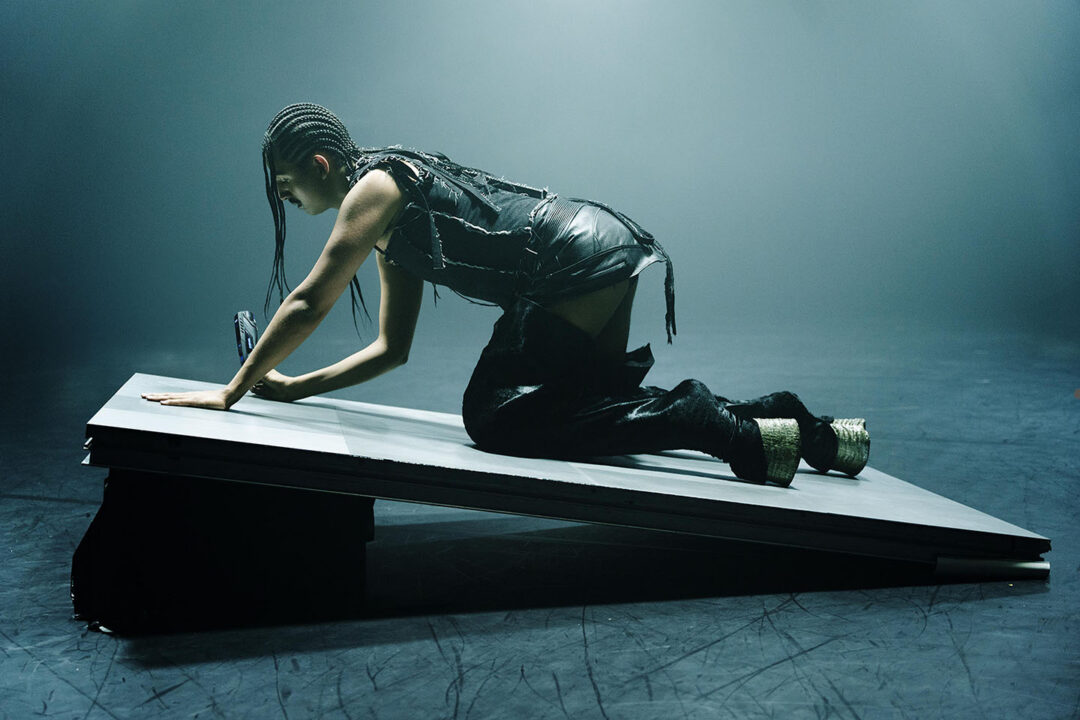
Ruins of the now
With their recently premiered Dawn Sweden-based performer and choreographer Adam Seid Tahir steers the festival’s ‘ruin’ theme down a more allegorical path. Alone in thick haze and poised atop a tilted metallic ramp, Tahir carefully etches its surface with a buzzy electric drill. Cloven hooves strapped to their feet, they lunge forward to descend on stage. Their crawling routine cuts through clouds of billowing smoke to chart an unpredictable itinerary. At times jittery and rapid, but then again lunging and feline, Tahir explores every shadowed corner to a soundtrack of galloping horses. Just as in any ritual, the time here is suspended if not abolished altogether. Tahir’s attention to details is mesmerising: their fingers and palms caress the ground, then dart or hover, as if hesitating before moving on. A mermaid-stallion, they kneel in undulating invocation before leaning over the ramp, black liquid dripping from their lips. Even without grasping all Norse mythology references drawn by Tahir – made clear in the ramp’s engravings – their mythical and fleeting odyssey strikes a primal chord. Before vanishing in the twinkling lights of dawn.
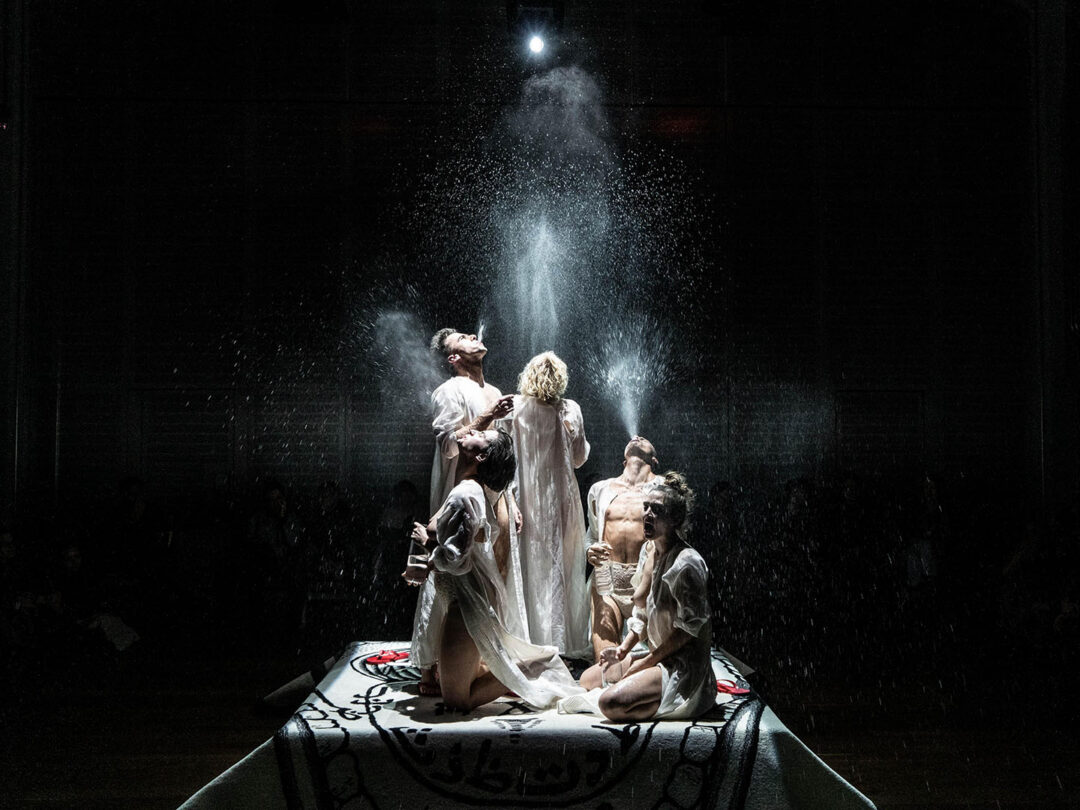
Mythology, albeit of another kind, is central to Ania Nowak’s Future Tongues, a piece that premiered at Warsaw’s Novy Theater in 2018 and was revived for the festival occasion. What begins as an allegory of analogue body language – an intimate and tactile lexicon – unravels into a bold rebellion against normative models of communication and authority of knowledge. Five performers, Nowak among them, appear on a pedestal in white robes and red sandals, reminiscent of papal iconography. While the overstage screen tells the Tower of Babel fable, the group enacts slow-motion Renaissance martyr tableaux.Their statuesque and evocative stillness gives way to a sensual choreography: they stroke, kiss, hug, claim and reclaim each other, make out and cuddle, then repeat. The show’s hypnotic rhythm never falters, building to an electrifying climax. In a standout scene, the extinct Latin language is hilariously warped to fit modern speech, nodding to lost artifacts of communication. With Future Tongues, Nowak delivers a dazzling, multi-layered work where intellectual ambition never eclipses raw exuberance and irreverence.
Argentinian choreographer’s Paula Almirón’s generous The River and the Devil also starts off with a legendary premise: a story of the Bolivian river Desaguadero demonised by colonial settlers for its once raging and unruly nature. Set amid salt sculptures with demonic horns and heaps of salt that evoke the river’s vanished spirit, Almirón’s undulating choreography – sweeping arms, spins, and twirling lunges – mirror the river’s lost flow, her breath rising and falling like the wind over a dry river bed. The audience is soon drawn in, taking turns to read out loud poetic fragments about the river’s spiritual landscape and its erasure under colonial rule: ‘A council determined that where there were devils, churches should be erected.’ As these words linger, Almirón’s movements tighten, her arms tremble, her body curling into sorrow over vanished lands and forgotten myths.
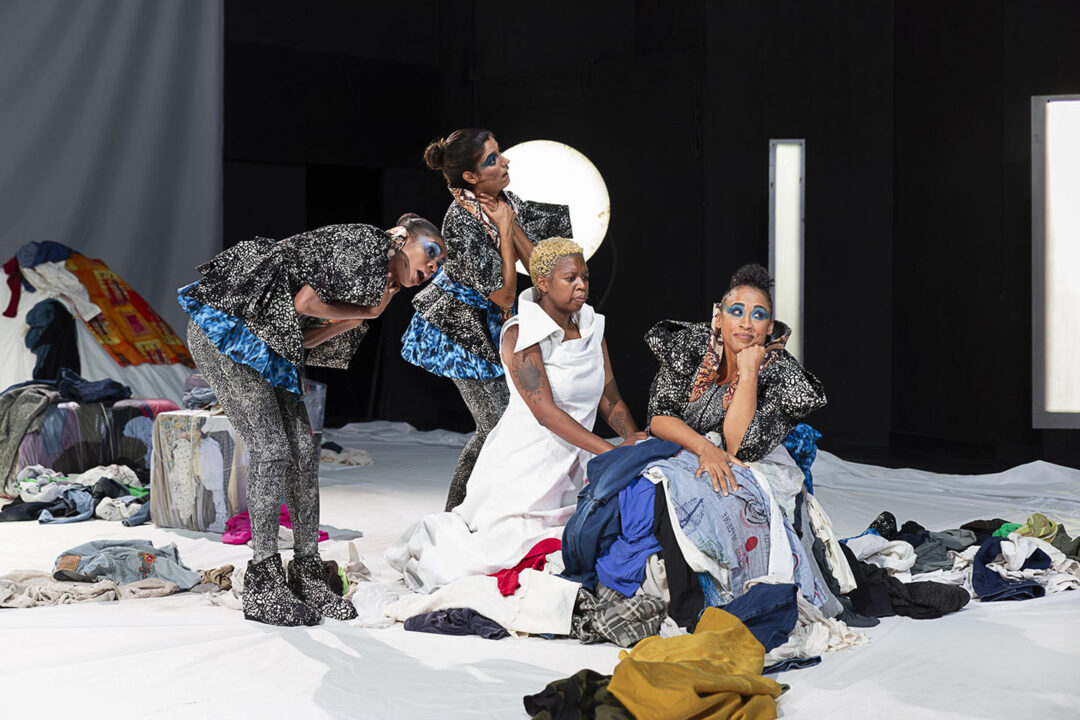
Colonial ecocide theme of the festival is taken even further with Ntando Cele’s gritty and vibrant Wasted Land. Set in a post-apocalyptic wasteland, the show skewers Western ‘feel-good’ environmentalism and its fast-fashion virtue-signaling with biting wit. Blending absurd comedy, musical numbers, dance, and direct address, Cele and three singer-performers peel away layers of irony, ultimately delivering a searing indictment of waste colonialism – the practice of sending tons of Western refuse to the Global South to preserve a clean conscience at home. Although at times hilarious and caustic, Cele’s performance lands with the disorienting force of TS Eliot’s poem referenced in the title. And it’s precisely the tension between the show’s vibrant, playful form and its political fury that catches the audience off guard, forcing us to confront uncomfortable truths.
The festival curators, Lena Kollender and Mateusz Szymanówka say that the ‘ruins’ concept came along when they already had a few shows in mind for the festival programme. Many works that had stayed with them over the last few years carried a feeling of imminent collapse, but instead of indulging in convenient despondency, conceived the ‘state of ruination’ as a site of departure and new beginning. Some of those works, like Ania Nowak’s Future Tongues, premiered quite a while ago; and both Kollender and Szymanówka underline that the absence of pressure to go after premieres allowed for more curatorial freedom.
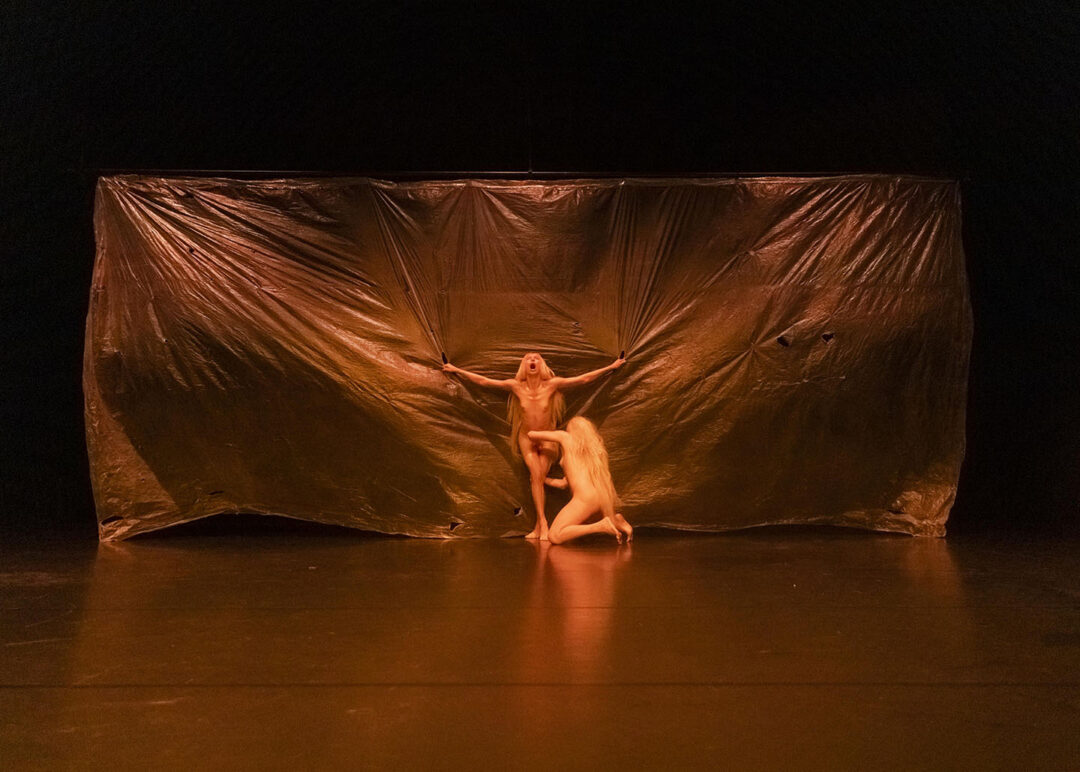
The last show of the festival, Eunuchs by Brazilian duo Irmãs Brasil, epitomised the curators’ vision and brought together, in a subliminal way, all the threads of meaning woven throughout three festival weeks. This staggeringly beautiful performance is conceived and performed by two trans women, Viní Ventania and Vitória Jovem, sisters on and off the stage. They appear on stage naked but for long blonde wigs, and start running, circling ever closer to the audience, eyes scanning, bodies locking into swan-like poses and explosive tuck jumps. But this is where the plot thickens. Seductive and menacing, once centaurs, now kleptomaniac mermaids, Ventania and Jovem seize audience belongings and fling them upstage, dash onto the spectators’ knees, lick their necks and shoulders, seek comfort in their arms, but then again thrust their hands to a shoe or a backpack, rip tickets or grab water bottles. What looks at first like gratuitous confrontation reveals itself to be a meticulously negotiated dialogue. Every gesture is brokered through eye contact and body language. Yes, for their crasser interactions they pick mostly on cis-male looking spectators, and yes, they go far. No one is off the hook, but whenever someone firmly rejects a stroke or a ‘lemme take your purse’ lunge, they draw back. During the post-show talk both admit that they can instantly recognise who is seeing a trans woman’s body for the first time, who is fetishising them and who is recoiled. Spectators, stripped of their ‘protected status’ as if to match the performers’ nudity, are drawn into a collaborative work that exposes them, to a slight degree, to the overwhelming daily violence trans women endure – and also the fierce tenderness they share. The brutality turns inward too: the sisters drag each other by the genitals in a simulated castration, paint one another with red lipstick, and end with a haunting crucifixion tableau – Ventania wailing, arms outstretched against a translucent tarp hanging upstage. A chilling final chord of the whole festival.
‘
There is no right way of dealing with the ruins of the past
A few pearl-clutching gasps aside, viewers spill out of Sophiensaele’s Kantine, visibly spellbound. Irmãs Brasil shatters our expectations of what artists can demand of spectators and of themselves, their shape-shifting performance working as a mirror to their own transition. Symbols and emotions morph fluidly too, stirring raw reactions – palpable when the artistic crew meet the crowd in the courtyard after the show. Their dramatic and deeply personal (im)pertinence, along with their daring yet careful take on theatrical conventions, produces a dazzling effect of a snapped puzzle piece. It’s as if all the questions that haunted the festival seem suddenly resolved and the lingering melancholy of previous shows falls away, making way for renewal. There is no right way of dealing with the ruins of the past: wistful longing is no more therapeutic than forgetfulness. But in their broken outlines, we must find the shape of what is yet to be built and reclaimed – a tenderness that grows precisely where the cracks run deepest. ●
15–31.05.2025, Sophiensaele, Berlin


